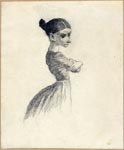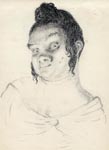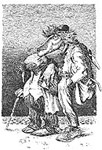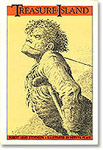Illustration
In Mervyn Peake’s talk broadcast by the BBC in September 1947, he describes how he became diverted from painting to book illustration: “All my life I have been painting and making drawings, but I only started illustrating books after I was conscripted in 1940.”
Asked to illustrate The Hunting of the Snark in 1941, he set out to study as many notable drawings by other illustrators as he could, these to act as a basis for his technique: Hogarth, Cruickshank, Durer, Blake, Dore, Goya and many others were rigorously scrutinised. He held a writer’s respect for other writers when asked to illustrate this and other books, and felt that when accepting the work, he should “subordinate myself totally to the book, and slide into another man’s soul”.
The Rime of the Ancient Mariner
For his illustrations for The Rime of the Ancient Mariner, published in 1943, he used a fine cross-hatching style which was later used for Alice’s Adventures in Wonderland and Through the Looking Glass, published in 1946 and 1954. Along with those for Treasure Island (following page), these are his best-known illustrations.
Bleak House
In the introduction to the 1983 Methuen edition of Bleak House Edward Blishen writes ’Peake establishes himself as one of the foremost of Dicken’s illustrators with Gothic exaggeration in which the comic is always the close companion of the sinister, as natural to Peake as it was to Dickens: but he joins to it a prodigious depth of feeling and power to suggest the essence of a character in the very line he employs’. Begun in 1945 following an invitation to illustrate the novel the published drawings were not seen however until 1983.
Writing in A World Away Maeve Gimore gives a glimpse of the feeling her husband had for Dickens, and ‘for this novel in particular before he ever put pen to drawing paper. It was just after the war, he was busy with illustrations to Grimms’ Fairy Tales, and while he worked on these in the evenings ensconsed behind his drawing board, trapped by it and the fine mapping pens and Indian ink which he used I would read to him; among the books preferred being Bleak House and several other Dickens’.
Alice’s Adventures in Wonderland
The illustrations for Alice’s Adventures in Wonderland were first published by The Continental Book Company/Zephyr Press in Sweden in 1946, and the first UK publication was by Allan Wingate in 1954. Republished by Methuen from 1978 to 1985, and by Bloomsbury with new introductions in 2001.
Treasure Island
From his earliest days as a boy in China, Treasure Island had been one of his favourite books. He would often lie in the shade, on hot days, memorizing every line, such was the power of the novel on his fertile and receptive imagination.
The first edition with his own illustrations appeared in 1949, and received many very enthusiastic reviews, especially from some of Stevenson's countrymen. The Glasgow Herald wrote 'in these drawings fear, terror, evil and humour are captured, and transfixed'. 'The drawings - tense, eerie and dramatic - abate nothing of the power of the narrative' wrote the reviewer in The Scotsman.























